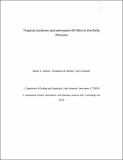Tropical cyclones and permanent El Nino in the early Pliocene epoch
Author(s)
Fedorov, Alexey V.; Brierley, Christopher M.; Emanuel, Kerry Andrew
DownloadFedorovBrierleyEmanuel FinalArticle.pdf (1.001Mb)
OPEN_ACCESS_POLICY
Open Access Policy
Creative Commons Attribution-Noncommercial-Share Alike
Alternative title
Tropical cyclones and permanent El Niño in the early Pliocene epoch
Terms of use
Metadata
Show full item recordAbstract
Tropical cyclones (also known as hurricanes and typhoons) are now believed to be an important component of the Earth’s climate system1, 2, 3. In particular, by vigorously mixing the upper ocean, they can affect the ocean’s heat uptake, poleward heat transport, and hence global temperatures. Changes in the distribution and frequency of tropical cyclones could therefore become an important element of the climate response to global warming. A potential analogue to modern greenhouse conditions, the climate of the early Pliocene epoch (approximately 5 to 3 million years ago) can provide important clues to this response. Here we describe a positive feedback between hurricanes and the upper-ocean circulation in the tropical Pacific Ocean that may have been essential for maintaining warm, El Niño-like conditions4, 5, 6 during the early Pliocene. This feedback is based on the ability of hurricanes to warm water parcels that travel towards the Equator at shallow depths and then resurface in the eastern equatorial Pacific as part of the ocean’s wind-driven circulation7, 8. In the present climate, very few hurricane tracks intersect the parcel trajectories; consequently, there is little heat exchange between waters at such depths and the surface. More frequent and/or stronger hurricanes in the central Pacific imply greater heating of the parcels, warmer temperatures in the eastern equatorial Pacific, warmer tropics and, in turn, even more hurricanes. Using a downscaling hurricane model9, 10, we show dramatic shifts in the tropical cyclone distribution for the early Pliocene that favour this feedback. Further calculations with a coupled climate model support our conclusions. The proposed feedback should be relevant to past equable climates and potentially to contemporary climate change.
Date issued
2010-02Department
Massachusetts Institute of Technology. Department of Earth, Atmospheric, and Planetary SciencesJournal
Nature
Publisher
Nature Publishing Group
Citation
Fedorov, Alexey V., Christopher M. Brierley, and Kerry Emanuel. “Tropical Cyclones and Permanent El Niño in the Early Pliocene Epoch.” Nature 463.7284 (2010) : 1066-1070.
Version: Author's final manuscript
ISSN
1476-4687
0028-0836